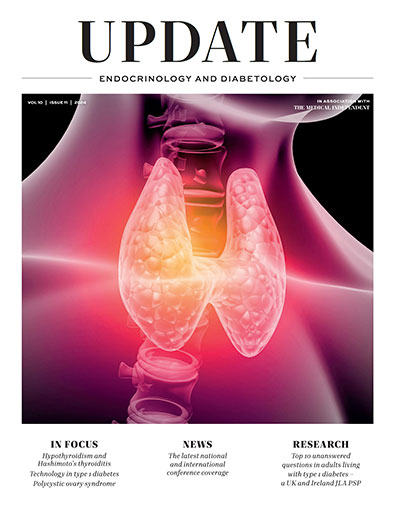Type 2 diabetes is a complex chronic disease, which requires a multifactorial behavioural and pharmacological approach to treatment in order to prevent or delay complications and maintain quality-of-life. This includes management of blood glucose levels, weight, cardiovascular risk factors, comorbidities, and complications. A holistic, person-centred approach is essential to enhance engagement, and careful consideration of social determinants of health and preference of the person living with diabetes must guide individualisation of treatment goals and strategies.1 This module will summarise the latest guidelines on the management of type 2 diabetes in non-pregnant adults.
Principles of glycaemic control
Achieving recommended glycaemic targets has been shown to substantially reduce the onset and progression of microvascular complications in patients with type 2 diabetes. Target HbA1c for adults with a life expectancy of >10 years is approximately 53mmol/mol. Aiming for a lower HbA1c level than this may be associated with significant hypoglycaemia and other adverse treatment effects. Higher HbA1c targets are appropriate in cases of limited life expectancy, advanced complications, or if factors such as frailty are present.1 Monitoring of blood pressure, lipids, and other risk factors such as smoking and alcohol intake is extremely important in people with type 2 diabetes; however, detailed discussion of these is beyond the scope of this module.
DESMOND
Diabetes Education and Self-Management for Ongoing and Newly Diagnosed (DESMOND) is a free HSE course available to people with type 2 diabetes. Patients are provided with up-to-date information and practical skills to manage their diabetes, including diet and exercise, blood glucose monitoring, smoking cessation, eye care, and foot care.2
Weight loss of 5-to-15 per cent should be a primary target of management for many people living with type 2 diabetes. Weight loss of 5-to-10 per cent confers metabolic improvement, and weight loss of 5-to-15 per cent or more can have a disease-modifying effect and lead to remission of diabetes.1
Physical activity significantly impacts cardiovascular health in type 2 diabetes. Individuals living with type 2 diabetes are advised to undertake 30 minutes of moderate exercise at least five times per week.1
Oral medications for lowering glucose
Metformin
Metformin has traditionally been recommended as first-line therapy for the management of type 2 diabetes due to its high efficacy in lowering HbA1c, minimal hypoglycaemia risk, weight neutrality, good safety profile, and low cost. Metformin should not be used in people with an estimated glomerular filtration rate (eGFR) <30ml/min per 1.73m,2 and dose reduction should be considered when the eGFR is <45ml/min per 1.73m.2 Metformin use may lower serum vitamin B12; therefore, periodic monitoring and supplementation are recommended.1
Sodium-glucose cotransporter-2 (SGLT2) inhibitors
SGLT2 inhibitors reduce plasma glucose by enhancing urinary excretion of glucose. They have intermediate-to-high glycaemic efficacy, with lower glycaemic efficacy at lower eGFR. Cardiorenal outcome trials have demonstrated their efficacy in reducing the risk of major adverse cardiovascular events, cardiovascular death, myocardial infarction (MI), hospitalisation for heart failure, and improving renal outcomes in individuals with type 2 diabetes.
In patients with established cardiovascular disease, heart failure, or chronic kidney disease, early combination therapy with metformin should be considered at treatment initiation provided the eGFR is above the threshold for metformin initiation. Their use should also be considered in those who are considered high risk for cardiovascular disease.1
SGLT2 inhibitors are associated with increased risk of urinary tract infections. They are also associated with a low but serious risk of euglycaemic diabetic ketoacidosis (DKA).1 Patients should be advised to hold the medication if they are unwell or fasting for a procedure, otherwise known as sick-day rules. Many centres provide patients with written information leaflets or alert cards, and the risk of euglycaemic DKA should be reiterated at each visit.
Glucagon-like peptide-1 (GLP-1) receptor agonists
GLP-1 receptor agonists increase glucose-dependent insulin secretion and glucagon suppression, slow gastric emptying, curb post-meal glycaemic increments, and reduce appetite, energy intake, and body weight. The most common side-effects of GLP-1 receptor agonists are nausea, vomiting, and diarrhoea, which tend to occur during initiation and dose escalation, and diminish over time. Gradual up-titration is recommended to mitigate gastrointestinal side-effects. Patients should be encouraged to eat slowly, stop eating when full, and not to eat when not hungry.
Studies have shown average weight loss of 5.5kg with semaglutide 1mg weekly; however, on stopping the drug people regain approximately one-third of the weight lost. GLP-1 receptor agonists are an appropriate second-line agent in patients whose primary target is weight loss and who do not have cardiovascular disease, heart failure, or chronic kidney disease.1 GLP-1 receptor agonists are contraindicated in people at risk for medullary thyroid cancer.
In patients with pre-existing diabetic retinopathy and high glycaemic levels, their use can lead to increased retinopathy complications due to the magnitude and rapidity of HbA1c reduction. They are also associated with an increased risk of gallbladder and biliary diseases.1
Dipeptidyl peptidase 4 (DPP-4) inhibitors
DPP-4 inhibitors inhibit the enzymatic inactivation of endogenous incretin hormones, resulting in glucose-dependent insulin release and a decrease in glucagon secretion. They have a more modest glucose-lowering effect and are weight neutral with minimal risk of hypoglycaemia.1
Sulfonylurea
Sulfonylureas have high glucose-lowering efficacy; however, due to their glucose-independent stimulation of insulin secretion, they are associated with an increased risk of hypoglycaemia. They are also associated with weight gain. Use of sulfonylureas for early intensive blood glucose control has been shown to significantly reduce the risk of microvascular complications; however, some observational studies raised concerns about adverse cardiovascular outcomes with their use.1
Thiazolidinediones (TZDs)
TZDs increase insulin sensitivity and have high glucose-lowering efficacy. In the PROactive trial,3 TZDs were shown to reduce secondary cardiovascular endpoints in adults with type 2 diabetes and macrovascular disease. The IRIS study demonstrated that in adults without diabetes, but with insulin resistance and a recent history of stroke or transient ischaemic attack (TIA), there was a lower risk of stroke or MI with pioglitazone.4 These benefits must be balanced with the possible side-effects of fluid retention and congestive heart failure, weight gain, and bone fracture. These side-effects can be mitigated by using lower doses and combining TZDs with other medications that promote weight loss and sodium excretion, such as SGLT2 inhibitors and GLP-1 receptor agonists.1
Combination therapy
Early use of combination therapy allows tighter glycaemic control than monotherapy, and therefore, is indicated in those with a HbA1c >1.5 per cent above their target at diagnosis. Immediate and sustained glycaemic control should be particularly pursued in young adults with type 2 diabetes, aiming for HbA1c <53mmol/mol; therefore, combination therapy should be considered in this group at diagnosis. This allows the best opportunity to avoid complications of diabetes across their lifespan.1
Insulin
Insulin therapy lowers glucose in a dose-dependent manner; however, its efficacy and safety are largely dependent on the education and support provided to facilitate self-management. Challenges of insulin therapy include weight gain, risk of hypoglycaemia, the need for regular glucose monitoring, and cost.
Comprehensive education on self-monitoring of blood glucose, diet, injection technique, self-titration of insulin, and prevention and treatment of hypoglycaemia are essential when initiating insulin therapy.1
Starting doses of basal insulin are estimated based on body weight (0.1-0.2 units/kg per day) and the degree of hyperglycaemia. Short- and rapid-acting insulin can be added to basal insulin to intensify treatment and optimise prandial blood glucose levels. Premixed insulins combine basal insulin with mealtime insulin in the same pen. This offers convenience for some but reduces treatment flexibility.1
Patients should continue metformin, SGLT2 inhibitors, and GLP-1 receptor agonists to avoid weight gain and limit insulin dose and hypoglycaemia risk. Sulfonylureas should be discontinued due to the increased risk of hypoglycaemia.1
Combination GLP-1-insulin therapy
A fixed-ratio combination of a GLP-1 receptor agonist (liraglutide) with a basal insulin analog (insulin degludec) is available as Xultophy. This combination results in greater glycaemic lowering efficacy than its individual components, with less weight gain and lower rates of hypoglycaemia than with intensive insulin regimes, as well as better gastrointestinal tolerability than with a GLP-1 receptor agonist alone.1
Screening and monitoring
In primary care, under the Diabetes Cycle of Care, now part of the chronic disease management (CDM) programme, GMS patients with type 2 diabetes are entitled to two visits a year.
Blood glucose monitoring
Regular capillary blood glucose monitoring helps with self-management and medication adjustment, particularly in those using insulin. In those not using insulin, regular glucose monitoring is of limited benefit while adding burden and cost.1
RetinaScreen
Anyone with diabetes can develop diabetic retinopathy, which can lead to significant vision loss if untreated. The longer someone has diabetes, the more likely they are to develop the condition. Poor glycaemic control in diabetes can make diabetic retinopathy worse and can increase the risk of developing sight problems.
Risk factors for diabetic retinopathy
- Poor blood glucose control;
- High blood pressure;
- Raised triglycerides;
- Pregnancy (not gestational diabetes).
During pregnancy, diabetes can worsen diabetic retinopathy. Common signs and symptoms include:
- Blurred or distorted vision (linked to blood glucose levels);
- Floaters (small black spots) and flashing lights;
- Trouble reading or seeing faraway objects;
- Loss of central vision;
- Sudden loss of vision (blindness);
- New colour blindness or seeing colours as faded;
- Poor night vision.
Diabetic retinopathy eye screening is a key part of diabetes care. The National Diabetic Retinal Screening Programme, Diabetic RetinaScreen, offers free, regular diabetic retinopathy screening to all people with diabetes aged 12 and older. See www.diabeticretinascreen.ie for further information.
Foot care
Patients with diabetes are at a 15-to-40-fold higher risk of a lower limb amputation than a non-diabetic patient. Early recognition and management of independent risk factors for ulcers and amputations can prevent or delay the onset of adverse outcomes.
All individuals with diabetes should receive an annual foot examination to identify their risk stratification and appropriate referral to specialists if required. In addition, all patients should be educated regarding foot care and the importance of their annual foot screen along with the management they may require. In 2021, the HSE National Clinical Programme for Diabetes published the Diabetic Foot Model of Care, which outlines the care diabetes patients should receive in relation to monitoring and treating diabetic foot issues.5
Driving guidelines
People with diabetes who are treated with insulin or sulfonylureas must check their blood glucose level before driving and every two hours while driving. If blood glucose is <5.0mmol/l, they should not drive. If a person develops hypoglycaemia while driving, they should stop the car, switch off the engine, take the keys out of the ignition, and move from the driver’s seat. They should take appropriate action to treat their hypoglycaemia and they should not drive again until 45 minutes after their blood glucose level has returned to normal.
People with type 2 diabetes must inform the National Driver Licence Service (NDLS) if they are treated with insulin or tablets which carry a risk of inducing hypoglycaemia, eg, sulfonylureas.6
Continuous glucose monitoring (CGM)
CGM devices provide interstitial glucose readings from sites in the abdomen or arm and make use of alarms and alerts to improve glycaemic control and reduce frequency of hypoglycaemia. ‘Time in range’ is defined as the percentage of time that CGM readings are in the range of 3.9-10.0mmol/L. Time in range is associated with the risk of microvascular complications and can be used for assessment of glycaemic management.
A HbA1c <53mmol/mol is equivalent to a time in range of >70 per cent, with additional recommendations to aim for time below range of less than 4 per cent. Like HbA1c targets, a lower percentage time in range is appropriate in cases of limited life expectancy, advanced complications, or if factors such as frailty are present. In the Republic of Ireland, CGM devices are not automatically funded for people with type 2 diabetes. Individual applications can be made for reasons such as hypo unawareness or severe needle phobia.
Support
Diabetes Ireland is the national charity dedicated to helping people with diabetes. It achieves this by providing support and education (including free online educational courses and support groups) to everyone affected by diabetes. It also raises public awareness of diabetes and its symptoms, and actively funds research into finding a cure for diabetes. See www.diabetes.ie.
Resources
References
1. Davies MJ, Aroda VR, Collins BS, et al. Management of hyperglycemia in Type 2 diabetes, 2022. A Consensus Report by the American Diabetes Association (ADA) and the European Association for the Study of Diabetes (EASD). Diabetes Care. 2022;45(11):2753-2786.
2. Health Service Executive. Type 2 diabetes education and courses: DESMOND. August 2020. Available at: www2.hse.ie/conditions/type-2-diabetes/courses-and-support/desmond/.
3. Erdmann E, Dormandy J, Wilcox R, Massi-Benedetti M, Charbonnel B. PROactive 07: Pioglitazone in the treatment of type 2 diabetes: Results of the PROactive study. Vasc Health Risk Manag. 2007;3(4):355-70.
4. Kernan WN, Viscoli CM, Furie KL, et al. Pioglitazone after ischaemic stroke or transient ischaemic attack. N Engl J Med. 2016;374(14):1321-1331.
5. HSE National Clinical Programme for Diabetes. Diabetic foot model of care. 2021. Available at: www.hse.ie/eng/about/who/cspd/ncps/diabetes/moc/diabetic-foot-model-of-care-2021.pd
6. National Driver Licence Service. Diabetes and driving. 2022. Available at: www.ndls.ie/images/Documents/Guidelines/10424_Diabetes_and_Driving_DL_(hi-res_screen).pdf.
7. Irish College of General Practitioners (ICGP). A practical guide to integrated type 2 diabetes care. 2016. Available at: www.icgp.ie.






























